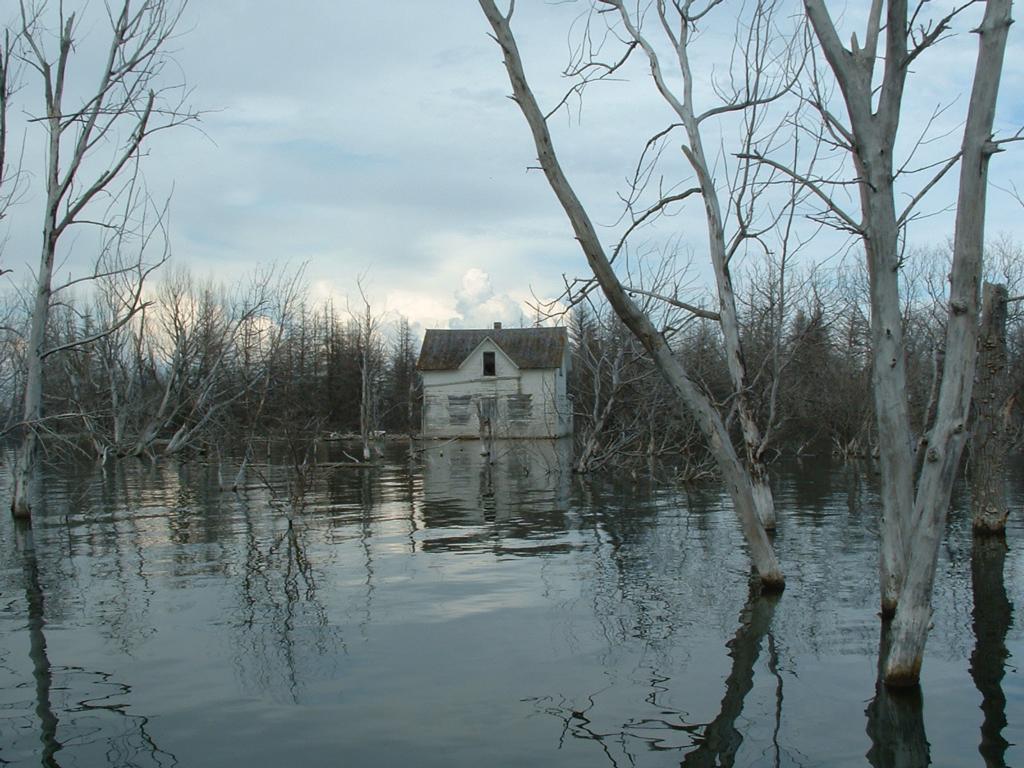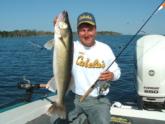Dicey Devils Lake

Decade of floods yields lake full of trees, farm implements, walleyes, other mischief for RCL Tour
SPIRIT LAKE, N.D. – Make no mistake, Devils Lake is a watery oddity. The place is certifiably large, for Mother Nature has been impulsively in charge ever since the early ’90s, when record rainfalls started swelling Devils nearly three times its original size.
Indeed, following floods of Biblical proportions, the natural lake without an outlet has overrun its banks, flooding farms and fields in its reckless, unabated path to almost 150,000 acres. According to a prediction by the U.S. Army Corps of Engineers, Devils could explode to more than 500,000 acres by 2030.
“It’s been like living in a different climate,” says Jim Schiele, museums director of the area’s Lake Region Heritage Center. “I grew up here and we didn’t have three 7-inch rains in a summer. Now it rains for three days and won’t stop. To me, the lake is like a time bomb.”
And it’s a cruel irony when, just across the border in South Dakota, record drought has plagued and parched the state’s rivers and reservoirs. While Devils is exploding, so is its accompanying walleye fishery, which this week will test the mettle of 200 teams of competitors in final qualifying event of the 2003 Wal-Mart RCL Walleye Tour.
Test them Devils will when the field navigates waters with flooded forest and farm implements, then attempts to unravel the riddle of walleyes dispersing throughout the lake with the onset of summer. The fishes’ whereabouts, in fact, are somewhat unknown, or at least uncertain, when they have the option of shallow weeds, deep roads inundated with water and, of course, the forest of trees.
“Last time I came here, everyone said go fish in the trees,” says Kevin McQuoid, who won the last RCL event here in 2001. “I launched the boat and there were 2 million trees.”
Whereabouts unknown?
Further confounding the search for the RCL competitors is new water now accessible just since the last event two years ago. Among the places are Pelican Lake, a lake that Devils has overtaken, and East Bay, which McQuoid says has approximately doubled the available water compared with 2001.
 Meanwhile, McQuoid’s winning location near the passage to Pelican Lake has been filled in with a road and causeway-another cruel irony.
Meanwhile, McQuoid’s winning location near the passage to Pelican Lake has been filled in with a road and causeway-another cruel irony.
Another location that is better known to the field – and to one competitor, in particular – is a series of deep rock piles last year’s RCL champion, Bruce Samson, has mined for two wins on another tournament circuit.
Of considerable renown as well is a stretch of flooded cattails known as Minnewaukan Flats, a perfect place for trolling 20-foot depths with leadcore line with small crankbaits. Leadcore, it turns out, is just the technique to keep the lures a foot or so above the bottom.
The forest and the trees
Lately, during the pre-fishing period, the shallow fish have been drawing far more attention than the deep ones, since a hot bite has been taking place by casting crankbaits over and around the weeds and trees. How long they will stay shallow, though, is anyone’s guess.
McQuoid ventures his. “All the fish don’t leave the shallow weeds and trees,” he says. “But I think many of them could migrate to deeper ledges and the Minnewaukan Flats, typical midsummer areas.
But while the trees look so much the same, slight depth changes within them or the clustering of trees in tight tangles could make all the difference.
“Most of the time what I’m looking for in the trees is a ridge or a point,” McQuoid says. “Or I target a certain depth. I expect 11 feet to be more productive than 5 or 8 because the water is getting warmer.”
With the water – and weather – warming quickly, the shallow bite could lose its momentum and open the door to deep-water practitioners like Samson, a physician, or the versatile McQuoid, who is already anticipating what to do if the shallows fizzle. Over the last couple of days, water temperatures have climbed more than 10 degrees, to the 70s, with daytime temperatures as high as the 90s.
The warmer water, along with flat calm, has undoubtedly made the action in five feet of water or less more difficult. Whoever figures out where the walleyes go from here, and over the course of the next four days, should be able to subdue Devils, if only for the moment.
Wednesday’s takeoff begins at 7 a.m. at Spirit Lake Casino and Resort.